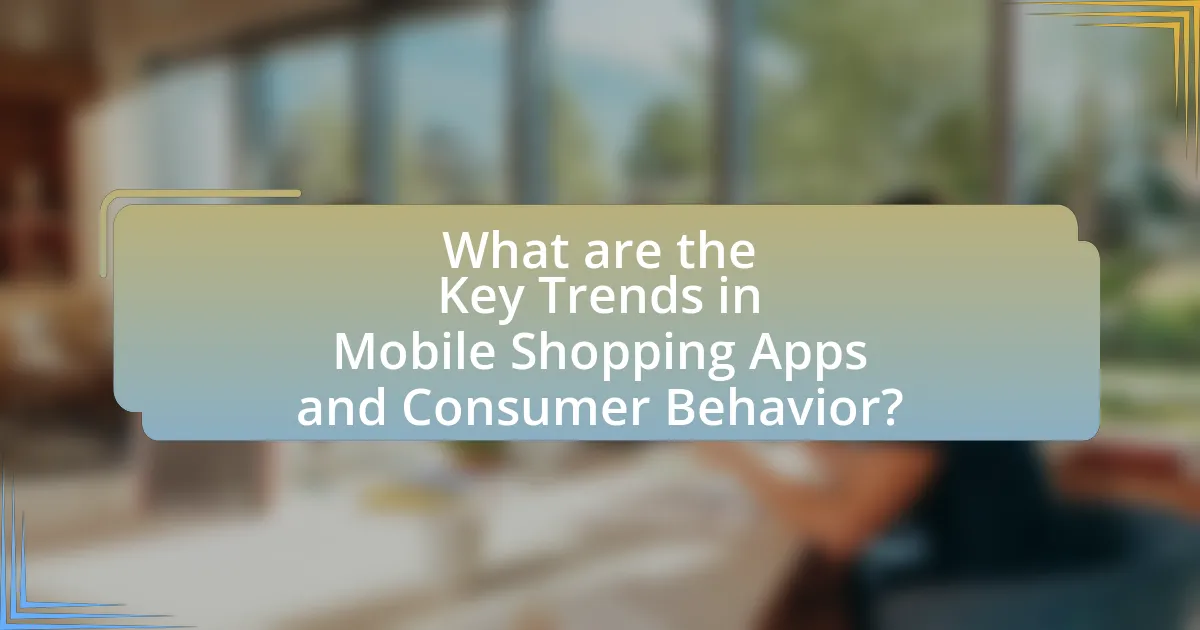Mobile shopping apps are software applications designed for smartphones and tablets that facilitate online shopping, significantly influencing consumer behavior by enhancing convenience and personalization. The article explores how these apps function within the retail landscape, their key features, and their impact on purchasing decisions, particularly among younger demographics. It also examines the psychological factors that drive consumer engagement, the role of technology in shaping the future of mobile shopping, and the challenges faced by both consumers and businesses. Additionally, it highlights trends in payment methods, impulse buying behavior, and best practices for optimizing app functionality to enhance user experience.

What are Mobile Shopping Apps and Their Role in Consumer Behavior?
Mobile shopping apps are software applications designed for smartphones and tablets that facilitate online shopping by allowing consumers to browse, compare, and purchase products directly from their devices. These apps significantly influence consumer behavior by enhancing convenience, providing personalized shopping experiences, and enabling instant access to promotions and product information. Research indicates that 79% of smartphone users have made a purchase using their device, highlighting the growing reliance on mobile shopping apps. Additionally, the ease of use and accessibility of these apps lead to increased impulse buying, as consumers can make purchases anytime and anywhere, thereby altering traditional shopping patterns.
How do Mobile Shopping Apps function in the retail landscape?
Mobile shopping apps function in the retail landscape by providing consumers with a convenient platform to browse, compare, and purchase products directly from their mobile devices. These apps leverage features such as personalized recommendations, user-friendly interfaces, and secure payment options to enhance the shopping experience. According to a report by Statista, mobile commerce accounted for 54% of total e-commerce sales in 2021, highlighting the significant role these apps play in driving retail growth. Additionally, mobile shopping apps utilize push notifications and location-based services to engage users, further influencing consumer behavior and purchasing decisions.
What features do Mobile Shopping Apps typically offer to consumers?
Mobile shopping apps typically offer features such as product search, personalized recommendations, secure payment options, and user reviews. These features enhance the shopping experience by allowing consumers to easily find products, receive tailored suggestions based on their preferences, complete transactions securely, and read feedback from other users. For instance, a study by Statista in 2021 indicated that 79% of consumers prefer apps that provide personalized shopping experiences, demonstrating the importance of tailored recommendations in driving user engagement.
How do these features influence consumer purchasing decisions?
Mobile shopping app features significantly influence consumer purchasing decisions by enhancing convenience, personalization, and engagement. Features such as user-friendly interfaces streamline the shopping process, making it easier for consumers to browse and purchase products quickly. Personalization features, like tailored recommendations based on browsing history, increase the likelihood of purchases by aligning product offerings with individual preferences. Additionally, engagement features such as push notifications and loyalty rewards encourage repeat purchases by keeping consumers informed and incentivized. Research indicates that 79% of consumers are more likely to make a purchase if they receive personalized offers, demonstrating the effectiveness of these features in driving consumer behavior.
Why are Mobile Shopping Apps becoming increasingly popular among consumers?
Mobile shopping apps are becoming increasingly popular among consumers due to their convenience and accessibility. These applications allow users to shop anytime and anywhere, significantly enhancing the shopping experience. According to a report by Statista, mobile commerce accounted for 54% of total e-commerce sales in 2021, highlighting the growing reliance on mobile platforms for shopping. Additionally, features such as personalized recommendations, easy payment options, and exclusive discounts further attract consumers to mobile shopping apps, making them a preferred choice for many.
What demographic trends are associated with the use of Mobile Shopping Apps?
The use of mobile shopping apps is predominantly associated with younger demographics, particularly Millennials and Generation Z. Research indicates that approximately 79% of Millennials and 67% of Gen Z consumers utilize mobile shopping apps, driven by their comfort with technology and preference for convenience. Additionally, urban dwellers show a higher propensity for mobile shopping, as they often have greater access to smartphones and faster internet connections. Gender trends also emerge, with studies revealing that women are more likely to use mobile shopping apps than men, particularly for fashion and beauty products. These demographic trends highlight the significant influence of age, location, and gender on the adoption and usage of mobile shopping applications.
How do convenience and accessibility impact consumer preferences?
Convenience and accessibility significantly influence consumer preferences by enhancing the shopping experience and reducing barriers to purchase. When consumers find it easy to access products and services, they are more likely to engage in purchasing behavior. For instance, a study by the National Retail Federation found that 70% of consumers prefer shopping with retailers that offer mobile apps, highlighting the importance of convenience in their decision-making process. Additionally, accessibility through mobile shopping apps allows consumers to shop anytime and anywhere, which aligns with their busy lifestyles and increases the likelihood of impulse purchases. This correlation between convenience, accessibility, and consumer preferences underscores the critical role that mobile shopping apps play in shaping modern consumer behavior.
What psychological factors influence consumer behavior in Mobile Shopping Apps?
Psychological factors that influence consumer behavior in mobile shopping apps include convenience, social proof, personalization, and perceived value. Convenience drives users to prefer mobile apps due to their ease of use and accessibility, leading to increased purchase frequency. Social proof, such as user reviews and ratings, affects consumer trust and decision-making, as individuals often rely on the experiences of others. Personalization enhances user engagement by tailoring recommendations and offers based on individual preferences and behaviors, which can significantly boost conversion rates. Lastly, perceived value, influenced by pricing strategies and promotional offers, impacts consumers’ willingness to make purchases, as they assess the benefits relative to the costs. These factors collectively shape the shopping experience and influence purchasing decisions in mobile environments.
How does the design and user experience of an app affect consumer engagement?
The design and user experience of an app significantly influence consumer engagement by directly affecting usability, satisfaction, and retention rates. A well-designed app with intuitive navigation and appealing aesthetics enhances user satisfaction, leading to increased time spent on the app and higher likelihood of repeat visits. Research indicates that 88% of users are less likely to return to a site after a bad experience, highlighting the importance of user experience in maintaining consumer interest. Furthermore, apps that prioritize user feedback and continuously improve their design can foster a loyal user base, as 70% of consumers are more likely to engage with brands that provide personalized experiences.
What role does social proof play in consumer decision-making within these apps?
Social proof significantly influences consumer decision-making within mobile shopping apps by providing validation through user reviews, ratings, and social interactions. This validation helps consumers feel more confident in their purchasing choices, as studies show that 70% of consumers are influenced by online reviews when making decisions. Additionally, the presence of high ratings and positive feedback can lead to increased trust in the app and its offerings, ultimately driving higher conversion rates.
How do Mobile Shopping Apps affect traditional shopping behaviors?
Mobile shopping apps significantly alter traditional shopping behaviors by increasing convenience and accessibility for consumers. These apps enable users to browse and purchase products from anywhere at any time, leading to a decline in foot traffic to physical stores. According to a report by eMarketer, mobile commerce accounted for 72.9% of total e-commerce sales in 2021, illustrating a shift in consumer preference towards mobile platforms over traditional retail experiences. This shift is further supported by the fact that 79% of smartphone users have made a purchase using their device, indicating a strong inclination towards mobile shopping. Consequently, traditional retailers are compelled to adapt their strategies, often integrating online and offline experiences to retain customers.
What are the implications of Mobile Shopping Apps on consumer loyalty?
Mobile shopping apps significantly enhance consumer loyalty by providing personalized experiences and convenience. These applications allow retailers to gather data on consumer preferences and behaviors, enabling tailored marketing strategies that resonate with individual users. For instance, a study by eMarketer found that 79% of smartphone users prefer shopping through apps due to their ease of use and personalized offers. This personalization fosters a sense of connection and satisfaction, leading to repeat purchases and brand loyalty. Additionally, mobile shopping apps often incorporate loyalty programs that reward users for their purchases, further incentivizing continued engagement with the brand.

What are the Key Trends in Mobile Shopping Apps and Consumer Behavior?
Key trends in mobile shopping apps and consumer behavior include the rise of personalized shopping experiences, increased use of mobile wallets, and the integration of augmented reality (AR) features. Personalized shopping experiences leverage data analytics to tailor product recommendations, enhancing user engagement; for instance, 80% of consumers are more likely to make a purchase when brands offer personalized experiences. The adoption of mobile wallets has surged, with a report indicating that mobile payment transactions are expected to reach $12 trillion by 2025, reflecting consumer preference for convenience and security. Additionally, AR features are transforming how consumers interact with products, with studies showing that 71% of consumers would shop more often if they could use AR to visualize products in their environment. These trends illustrate the evolving landscape of mobile shopping and its significant impact on consumer behavior.
How is technology shaping the future of Mobile Shopping Apps?
Technology is significantly shaping the future of mobile shopping apps by enhancing user experience through personalization, augmented reality, and advanced payment solutions. Personalization algorithms analyze consumer behavior and preferences, allowing apps to offer tailored product recommendations, which can increase conversion rates by up to 30%. Augmented reality features enable users to visualize products in their own environment, improving engagement and reducing return rates. Additionally, advancements in payment technology, such as mobile wallets and biometric authentication, streamline the checkout process, making it faster and more secure. These technological innovations are driving higher consumer satisfaction and loyalty in mobile shopping.
What emerging technologies are being integrated into Mobile Shopping Apps?
Emerging technologies integrated into mobile shopping apps include augmented reality (AR), artificial intelligence (AI), and blockchain. Augmented reality enhances the shopping experience by allowing users to visualize products in their environment before purchase, which has been shown to increase conversion rates. Artificial intelligence personalizes user experiences through recommendations and chatbots, improving customer engagement and satisfaction. Blockchain technology ensures secure transactions and enhances transparency in supply chains, addressing consumer concerns about product authenticity. These technologies collectively transform mobile shopping by making it more interactive, personalized, and secure.
How do these technologies enhance the shopping experience for consumers?
Mobile shopping apps enhance the shopping experience for consumers by providing convenience, personalization, and real-time access to information. These technologies allow consumers to shop anytime and anywhere, significantly reducing the time and effort required to make purchases. For instance, a study by eMarketer found that 79% of smartphone users have made a purchase using their device, highlighting the convenience factor. Additionally, mobile apps utilize algorithms to analyze consumer behavior, offering personalized recommendations that cater to individual preferences, which can increase customer satisfaction and loyalty. Furthermore, features such as price comparison tools and instant access to product reviews empower consumers to make informed decisions, ultimately improving their overall shopping experience.
What are the current trends in consumer preferences regarding Mobile Shopping Apps?
Current trends in consumer preferences regarding mobile shopping apps indicate a strong inclination towards personalization, convenience, and social integration. Consumers increasingly favor apps that offer tailored recommendations based on their shopping history and preferences, enhancing their overall shopping experience. According to a 2023 survey by Statista, 70% of users prefer apps that provide personalized content and offers. Additionally, the demand for seamless payment options and quick checkout processes is rising, with 65% of consumers indicating that ease of payment significantly influences their app choice. Furthermore, social features, such as user reviews and social media integration, are becoming essential, as 58% of shoppers report that they trust peer recommendations over traditional advertising. These trends highlight a shift towards a more user-centric approach in mobile shopping applications.
How do personalization and customization features impact consumer satisfaction?
Personalization and customization features significantly enhance consumer satisfaction by creating tailored shopping experiences that meet individual preferences. When consumers encounter personalized recommendations and customizable options, they feel more valued and understood, leading to increased engagement and loyalty. Research indicates that 80% of consumers are more likely to make a purchase when brands offer personalized experiences, demonstrating a direct correlation between these features and consumer satisfaction. Furthermore, a study by McKinsey & Company found that personalization can lead to a 10-30% increase in revenue for retailers, underscoring the financial benefits of satisfying consumer needs through tailored offerings.
What trends are emerging in payment methods within Mobile Shopping Apps?
Emerging trends in payment methods within mobile shopping apps include the increasing adoption of digital wallets, contactless payments, and buy now, pay later (BNPL) options. Digital wallets, such as Apple Pay and Google Pay, are gaining popularity due to their convenience and security features, with a report from Statista indicating that mobile wallet transactions are expected to surpass $1 trillion by 2024. Contactless payments are also on the rise, driven by consumer demand for faster checkout experiences, with a survey by Mastercard revealing that 79% of consumers prefer contactless payments for their speed and ease. Additionally, BNPL services are becoming a preferred option for consumers seeking flexible payment solutions, with a study by Afterpay showing that 60% of millennials have used BNPL services, reflecting a shift in consumer behavior towards more manageable payment methods.
How do Mobile Shopping Apps influence impulse buying behavior?
Mobile shopping apps significantly influence impulse buying behavior by providing easy access to products and personalized shopping experiences. These apps utilize features such as push notifications, personalized recommendations, and streamlined checkout processes, which create a sense of urgency and convenience that encourages spontaneous purchases. Research indicates that 70% of consumers report making impulse purchases while using mobile shopping apps, highlighting their effectiveness in driving unplanned buying decisions. Additionally, the visual appeal and gamification elements within these apps further enhance user engagement, leading to increased likelihood of impulse buying.
What strategies do apps use to encourage spontaneous purchases?
Apps encourage spontaneous purchases through strategies such as personalized recommendations, limited-time offers, and gamification. Personalized recommendations utilize algorithms to analyze user behavior and suggest products that align with individual preferences, increasing the likelihood of impulse buying. Limited-time offers create a sense of urgency, prompting users to make quick decisions to avoid missing out on discounts or exclusive deals. Gamification elements, such as rewards and challenges, engage users and incentivize purchases by making the shopping experience more interactive and enjoyable. These strategies are supported by research indicating that urgency and personalization significantly enhance consumer engagement and drive impulsive buying behavior.
How does the layout and presentation of products affect impulse buying?
The layout and presentation of products significantly influence impulse buying by enhancing visibility and creating an appealing shopping environment. Research indicates that well-organized displays and attractive product arrangements can capture consumer attention, leading to spontaneous purchases. For instance, a study published in the Journal of Retailing found that products placed at eye level or in prominent positions are more likely to be bought impulsively, as they draw the shopper’s focus and create a sense of urgency. Additionally, visually appealing presentations, such as using vibrant colors and engaging signage, can evoke emotional responses that further encourage unplanned buying behavior.

What Challenges and Considerations Exist for Mobile Shopping Apps and Consumers?
Mobile shopping apps face several challenges and considerations that impact both their functionality and consumer experience. Security concerns are paramount, as consumers worry about data breaches and fraud; a study by McKinsey found that 60% of users are hesitant to share personal information due to these fears. Additionally, app usability is critical; research indicates that 70% of users abandon apps due to poor navigation or slow loading times. Furthermore, consumers often encounter issues with payment processing, where 30% of transactions fail due to technical glitches, leading to frustration and lost sales. Lastly, the need for effective customer support is essential, as 80% of consumers expect immediate assistance when issues arise, highlighting the importance of responsive service in retaining users.
What are the common concerns consumers have regarding Mobile Shopping Apps?
Common concerns consumers have regarding mobile shopping apps include security, usability, and product quality. Security is a primary issue, as consumers worry about data breaches and the safety of their personal information; a 2021 survey indicated that 43% of users are concerned about their financial data being compromised. Usability is another significant concern, with many users finding navigation and checkout processes cumbersome, which can lead to cart abandonment; studies show that 70% of users abandon their carts due to poor user experience. Lastly, consumers often question the quality of products purchased through apps, fearing that items may not match their descriptions or images, which is supported by research indicating that 30% of online shoppers have experienced receiving products that did not meet their expectations.
How do privacy and security issues affect consumer trust in Mobile Shopping Apps?
Privacy and security issues significantly undermine consumer trust in mobile shopping apps. When consumers perceive that their personal data is at risk or inadequately protected, they are less likely to engage with these applications. A study by the Pew Research Center found that 81% of Americans feel they have little to no control over the data collected about them, which directly correlates with their reluctance to use mobile shopping apps. Furthermore, incidents of data breaches, such as the 2019 Capital One breach affecting over 100 million customers, highlight the potential risks, leading to increased skepticism among users regarding the safety of their financial and personal information. This erosion of trust can result in decreased usage and lower sales for businesses relying on mobile shopping platforms.
What are the implications of app performance and reliability on consumer behavior?
App performance and reliability significantly influence consumer behavior by affecting user satisfaction and retention. High-performing and reliable apps lead to positive user experiences, which increase the likelihood of repeat usage and customer loyalty. According to a study by Apptentive, 53% of users will uninstall an app after just one bad experience, highlighting the critical nature of performance. Furthermore, a report from Google indicates that 53% of mobile site visits are abandoned if a page takes longer than three seconds to load, demonstrating that speed and reliability directly impact consumer engagement and purchasing decisions. Thus, app performance and reliability are crucial factors that shape consumer behavior in mobile shopping.
How can businesses optimize their Mobile Shopping Apps to enhance consumer experience?
Businesses can optimize their mobile shopping apps by implementing user-friendly interfaces, personalized recommendations, and efficient checkout processes. A user-friendly interface enhances navigation, making it easier for consumers to find products, which can lead to increased sales; studies show that 88% of online consumers are less likely to return to a site after a bad experience. Personalized recommendations, driven by data analytics, can increase conversion rates by up to 30%, as they cater to individual preferences and shopping behaviors. Additionally, streamlining the checkout process reduces cart abandonment rates, which average around 70%, by minimizing the number of steps required to complete a purchase. These strategies collectively enhance the consumer experience, leading to higher customer satisfaction and loyalty.
What best practices should businesses follow when designing Mobile Shopping Apps?
Businesses should prioritize user experience, security, and performance when designing mobile shopping apps. A seamless user experience includes intuitive navigation, fast loading times, and a visually appealing interface, which can lead to higher customer satisfaction and increased sales. Security is crucial; implementing features like secure payment gateways and data encryption protects user information, fostering trust. Performance optimization, such as minimizing app size and ensuring compatibility across devices, enhances usability and retention rates. According to a study by Statista, 79% of consumers who are dissatisfied with mobile app performance are less likely to return, highlighting the importance of these best practices.
How can businesses leverage consumer feedback to improve app functionality?
Businesses can leverage consumer feedback to improve app functionality by systematically collecting and analyzing user reviews and suggestions. This process allows businesses to identify common pain points and desired features, enabling them to prioritize updates that enhance user experience. For instance, a study by Apptentive found that 77% of users are more likely to recommend an app that actively incorporates feedback. By implementing changes based on this feedback, businesses can increase user satisfaction and retention, ultimately driving higher engagement and sales.
What practical tips can consumers follow to maximize their experience with Mobile Shopping Apps?
To maximize their experience with mobile shopping apps, consumers should utilize features such as personalized recommendations, price alerts, and user reviews. Personalized recommendations enhance the shopping experience by suggesting products based on previous purchases and browsing history, which can lead to more relevant choices. Price alerts notify users of discounts or price drops, ensuring they make purchases at the best possible prices. User reviews provide insights into product quality and performance, helping consumers make informed decisions. According to a study by Statista, 79% of consumers read reviews before making a purchase, highlighting the importance of this feature in mobile shopping apps.





